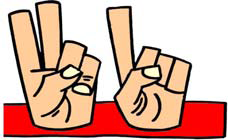This article is intended only as a brief overview.

The "system" described as 2-over-1 game-forcing refers to the following 6 bids :
1  - 2
- 2 
1  - 2
- 2 
1  - 2
- 2 
1  - 2
- 2 
1  - 2
- 2 
1  - 2
- 2 
When responder uses a game-forcing "2-over-1" bid he is informing opener that he, too, holds at least opening-bid values. Accordingly, the partnership may leisurely proceed to the optimum contract without fear of being dropped below game. Opener then should show his "shape," without implying # of HCP. I recommend to just "dive in." The finer points can be learned as you go.Try answering these questions and just assume "natural" with no science needed (other than that the 2-over-1 response has forced the partnership to game). From the answers, you can learn what the bids mean.
As opener, what do you rebid?
| You |
Opponent |
Partner |
Opponent |
1
|
Pass |
2
|
Pass |
| ?? |
|
|
|
| A) |
B) |
C) |
D) |
E) |
F) |
 54 54
 KQ10874 KQ10874
 AJ3 AJ3
 K4 K4 |
 32 32
 QJ1087 QJ1087
 A4 A4
 AQ54 AQ54
|
 AKJ2 AKJ2
 AQ876 AQ876
 A54 A54
 2 2
|
 AQ3 AQ3
 KQ876 KQ876
 AQ32 AQ32
 3 3
|
 QJ2 QJ2
 Q9764 Q9764
 Q92 Q92
 AQ AQ
|
 A2 A2
 AKQJ98 AKQJ98
 976 976
 52 52
|
ANSWERS (with further clarification)
A) 2 . Repeat the 6-card suit. Opener's first obligation is to show shape. Repeat a 6+ card suit regardless of HCP strength. Even with another ace, the rebid is 2
. Repeat the 6-card suit. Opener's first obligation is to show shape. Repeat a 6+ card suit regardless of HCP strength. Even with another ace, the rebid is 2 with 6+ hearts.
with 6+ hearts.
B) 3 . Forcing, of course—until at least game is reached. This says nothing about HCP.
. Forcing, of course—until at least game is reached. This says nothing about HCP.
C) 2 . Natural again – and just coincidental that you have extras. This bid would be made if the
. Natural again – and just coincidental that you have extras. This bid would be made if the  A were a low diamond.
A were a low diamond.
D) 2 . Natural. Don't jump with extras. Don't rebid notrump with a singleton. Slam exploration can come later; for now, look for the trump suit (or notrump).
. Natural. Don't jump with extras. Don't rebid notrump with a singleton. Slam exploration can come later; for now, look for the trump suit (or notrump).
E) 2NT. Natural—also, not promising extras.
F) 3 . An unnecessary jump should show a solid suit. Jump rebids don't promise anything other than a solid 6+ card suit (such as AKQJxx or KQJ10xx).
. An unnecessary jump should show a solid suit. Jump rebids don't promise anything other than a solid 6+ card suit (such as AKQJxx or KQJ10xx).
In the auction below, you are the responder. Again, you can just follow the guideline of "bid naturally."
| PARTNER |
Opponent |
YOU |
Opponent |
1
|
Pass |
2
|
Pass |
| 2NT |
Pass |
?? |
|
What is your second bid with each hand below?
| G) |
H) |
I) |
J) |
K) |
 KJ3 KJ3 |
 42 42 |
 4 4 |
 43 43 |
 KQJ KQJ |
 A2 A2 |
 AQJ AQJ |
 A5 A5 |
 AQ2 AQ2 |
 103 103 |
 KQ1087 KQ1087 |
 AQ8765 AQ8765 |
 AKQ10872 AKQ10872 |
 KQJ1082 KQJ1082 |
 AQ1084 AQ1084 |
 432 432 |
 A7 A7 |
 Q32 Q32 |
 52 52 |
 AQ5 AQ5 |
G) 3NT.
H) 3 . Forcing, of course. Stronger than jumping to game. In 2/1 GF auctions, a jump to game in a previously bid suit is the weakest action. It is an attempt to sign off and not look for slam.
. Forcing, of course. Stronger than jumping to game. In 2/1 GF auctions, a jump to game in a previously bid suit is the weakest action. It is an attempt to sign off and not look for slam.
I) 3 . No need to rush into Blackwood.
. No need to rush into Blackwood.
J) 4 . Jumping to game is weaker than staying low with 3
. Jumping to game is weaker than staying low with 3 (as in example H).
(as in example H).
K) 4NT Quantitative (4 would be Gerber--ace-asking).
would be Gerber--ace-asking).
An important part of the 2/1 GF system is to employ a 1NT bid (by an unpassed hand) in response to a major-suit opening bid as forcing (or semi-forcing) for one round. Unlike Standard American, this bid is not limited to 6 to 9 HCP. Normally, it shows 6 to 12 HCP. More on this can be found here.
Notes:
2-over-1 is game-forcing as long as responder is not a passed hand and there is no interference bidding (so, in competition, 2/1 is NOT game forcing).
The 2/1 Game Forcing system is really an outgrowth of Standard American and 5-card Majors and many of the methods and conventions employed are alike. There are more details—this mini-lesson is intended only as a brief overview of the principles. Also, more details are in "Larry Teaches 2/1 GF."
A 2-over-1 game force is not alertable.
The 1NT response is announced (by the opener) as "Forcing" or "Semi-forcing" -- whatever the partnership has agreed.
Yes, 1 -2
-2 should be played as GF. If faced with a choice between responding in a 4-card major or a 4-card minor (with enough for game), I recommend responding in the minor (to get into the comfortable 2/1 GF auction). You can always find the major later-there will be a later.
should be played as GF. If faced with a choice between responding in a 4-card major or a 4-card minor (with enough for game), I recommend responding in the minor (to get into the comfortable 2/1 GF auction). You can always find the major later-there will be a later.
Larry's 2/1 Workbook
BMS 2/1 Webinars by Michael Berkowitz
updated: Feb, 2016
